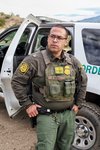
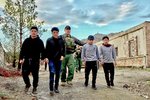




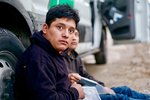


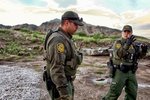
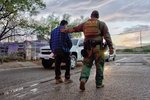
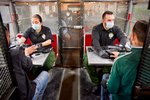
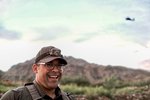
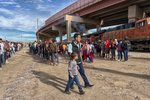
It’s 6 a.m. and still dark as we meet in the parking lot at the Sunland Park. Our group includes Laurie Smith, a photographer from Denver, me and three Border Patrol agents, Landon Hutchens from Texas who has organized this early morning ride-along for Laurie and me, plus Carlos Rivera and Orlando Marrero, both of whom were born in Puerto Rico.
Within five minutes, we encounter four migrants who had come down the steep, treacherous slopes of Monte Cristo Rey and dashed across the highway in front of our vehicle. The agents quickly detain them, have them take off their belts and shoelaces, place personal items like cell phones in plastic bags, give them receipts for these personal items, and search them.
These migrants look devastated; they have paid at least $5,000 dollars to a “coyote” for this arduous trip, hoping that it will lead to decent jobs in the United States.
We then run across two other groups, including one with a woman and her terrified 8 year-old daughter. The woman says she is a diabetic so Orlando, who is an EMT, immediately makes arrangements for her medical care.
So far this fiscal year the Border Patrol has had 18,897 rescues. This compares to 12,833 in the 2020-21 fiscal year. The medical care provided by EMTs like Orlando is an essential but little recognized part of the Border Patrol’s mission.
We then drive westward and see a red cross painted on the border wall. In late March, 2021 two sisters from Ecuador, age 3 and 5 were dropped over the 14 foot wall by smugglers. Because of a new surveillance system, the whole incident was filmed and Border Patrol agents were quickly able to rescue the girls. Otherwise, they could have died from exposure.
This cross is a reminder of the cruelty of the highly organized, multi-billion dollar, cartel dominated smuggling industry that originates in the Latin American countries from which the migrants come, stretches through Mexico into the United States where migrants are often held in stash houses and forced to come up with even more money if they want to be freed.
Our next stop is the Chihuahuita area of El Paso where there is a gap between two sections of the wall through which asylum seekers can pass in order to turn themselves in to the Border Patrol. We are all stunned to see a crowd of 300 to 400, mostly men and almost all from Venezuela.
Other than Syria, no country in the world has had a mass exodus that matches that of Venezuela. Roughly 25 percent of its population has fled because of poverty, corruption and violence. For us Americans, however, this exodus has been somewhat disguised because most of those fleeing Venezuela have traditionally gone south into Colombia.
Now they are making the highly dangerous trip north across the remote, roadless and highly dangerous Darien Gap on the border with Panama.
Some of these migrants are tired and scared as can be expected but many are cheerful, anxious to pose for photos and to describe their experiences and their hopes for the future.
Despite these enormous numbers, the processing begins to move quickly. Our agents say that morale is much higher than it was back in 2019 when they struggled with the surge of migrants and that they have made many improvements like the surveillance tower we saw earlier and a more efficient processing system. Perhaps more important, there is a powerful working relationship with the City of El Paso and with volunteer organizations like Annunciation House, the largest migrant shelter in El Paso.
By late morning our ride-along ends. Here are some reactions.
First, what was continuously obvious – both during the detentions near Monte Cristo Rey and the processing of the huge crowd at Chihuahuita – was the professionalism and courtesy of all the agents we observed. To quote Agent Marrero,
“I do it with dignity and respect towards the migrants,” Marrero said. “ ..make sure that they’re safe.”
Second, while the political debate over the wall continues, the Border Patrol is quietly doing a remarkable job of securing our border. For the last four years, I’ve been assisting migrant shelters in Juárez and advocating for the rights of migrants, but I also believe that our border needs to be secure and I now recognize how effectively and humanely the Border Patrol is doing it.
Third, roughly 95 percent of the migrants we saw had crossed the border peacefully to exercise their legal right to ask for asylum. The numbers of those crossing illegally are much smaller than we’re led to believe and most of them are simply looking for the kind of work they can’t find in their impoverished countries.
Morgan Smith has been documenting conditions on the Mexican border for the last decade and can be reached at Morgan-smith@comcast.net.